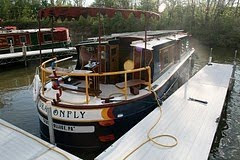 |
| Most daymarks are mounted on land, not rock cairns |
The Tenn Tom doesn't look like much at first glance. Construction was completed in 1984, and 26 years is not a whole lot of time for nature to reclaim bare earth.
So on the initial section, the 27 miles known as the "Divide Cut," it's clear you are traveling a canal. The banks are even and neatly leveled, plastered with rip-rap (small boulders that discourage soil erosion). Industrial-style cement walls border the occasional causeway that admits water from a small tributary creek. Grass, weeds and some small trees have grown on the sloping banks, softening the impression that you're traveling the water equivalent of an interstate highway.
 |
| The locks on the Tenn Tom were all built at the same time and they all look just the same |
The idea to create the Tenn-Tom goes back quite a ways. Exploring the region around 1760, the Marquiz de Montcalm wrote home to Louis XV of France that a canal connecting the Tennessee and Tombigbee Rivers would be a great idea, for the usual reason--to make it easier and faster to ship supplies and goods between the coast and the interior of the continent.
Obviously America aquired the region and the French never built that canal. In 1810 settlers in Tennessee asked Congress for a canal. In 1874 the government did the first feasibility study, and another in 1913. Conclusion both times? The project would be too expensive.
Congress approved the project in 1946, but opposition from the railroad industry (and members of Congress outside the region) prevented the project from going forward. President Johnson budgeted funds to get the project going. Construction was delayed because of "a lawsuit by a small group of environmentalists."
Ah, those pesky environmentalists.
It feels a little weird to be enjoying so much our trip down a waterway that was so controversial and apparently, mostly a bad idea. A guilty pleasure.
But we are enjoying it. There's hardly any boat traffic, commercial OR recreational. We have the water and the big locks pretty much to ourselves--no waiting to lock through. There's plenty of wildlife. Thousands of coots, squabbling and splashing and bringing up gouts of waterweed to nibble. As we cruised through a cold misty rain yesterday, an osprey hovered overhead, then plunged into the water. Gotta fuel the furnace, especially when it's cold.
Oh, speaking of the Panama Canal? The Tenn-Tom signed a memorandum of understanding with the Panama Canal Authority this summer. They agree to work jointly to promote the "All Water Route"-- transporting goods from Asia to the east coast of the United States via the Panama Canal.
I'll be interested to see what happens
P.S. More photos on Facebook at slowboatcruise (check the photo log for Nov. 4)





Cynthia . . . .
ReplyDeleteTenn-Tom and boondoggle? Not quite.
Although the Waterway has yet to match the projections made to justify its construction, the Corps of Engineers conservatively estimates that recreational boating alone is pumping at least $3 million a year into chronically poor eastern Mississippi and western Alabama Everyone agrees, however, the actual figure is at least double that amount.
Also, shipping millions of tons of freight on the Waterway not only saves money but also saves a tremendous amount of energy compared to that needed to ship the same commodities by either rail or truck.
And finally, that agreement with the Panama Canal will push us far more rapidly into trans-shipping overseas freight to inland ports. In this region, that will not only relieve congestion at New Orleans and Mobile but will also significantly reduce the amount of energy used for shipping.
It's very easy to make the wrong conclusions about the Tenn-Tom, particularly when looking at the present. By a wide margin, the best and most productive days of the Tenn-Tom are still ahead.
How lucky we are, then, to already have the Waterway built and ready to serve the region and the Nation in ways not even envisioned by those who promoted and built it.
Cruise on!
Fred Myers
Thoughtful comments, Fred, and very much to the point. Absolutely, barging freight is an energy-conserving way to go. It will be interesting to see what could be done to INCREASE use of the waterway since use has not met projections.)
ReplyDeleteI grew up on the Ala/Tombigbee rivers, as well as the Mobile River. Most of this was between 1950 and 1965 as a child and young adult. As a representative of the Home Builders Ass I testified in 1977 in Columbus to continue the project when President Carter was considering stopping it. Now in my 76th year I have wondered if this project was a political boondoggle or was worth the 2 billion in cost. My wife and I now live in Ecuador and we have no economic interests in the US, but I am working on a book that includes this period of time and curious as to what people think after 30 years since opening.
DeletePlease respond to gin.arnold@yahoo.com as the above is not a good address.
Delete